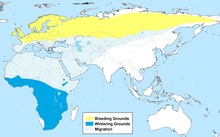Willow warbler
| Willow warbler | |
|---|---|

| |
| Scientific classification | |
| Domain: | Eukaryota |
| Kingdom: | Animalia |
| Phylum: | Chordata |
| Class: | Aves |
| Order: | Passeriformes |
| Family: | Phylloscopidae |
| Genus: | Phylloscopus |
| Species: | P. trochilus
|
| Binomial name | |
| Phylloscopus trochilus | |
| Subspecies | |

| |
| Yellow: Breeding (summer only) Blue: Non-breeding winter visitor Cross-hatched: migration. | |
| Synonyms | |
| |
The willow warbler (Phylloscopus trochilus) is a very common and widespread
It is a
Taxonomy
The willow warbler was
Before the English name was standardised to willow warbler by William Yarrell in 1843, it was sometimes called "willow wren".[8][9]
Three subspecies are recognised.[6] There is a clinal reduction in green and yellow plumage tones from west to east, with central birds browner and easternmost birds predominantly greyish:[2]
- P. t. trochilus (Linnaeus, 1758). Breeds Europe (from the Pyrenees and Alps northward) except northern Scandinavia, winters west Africa.
- P. t. acredula (Linnaeus, 1758). Breeds northern Scandinavia east to western Siberia, winters central Africa.
- P. t. yakutensis (Ticehurst, 1935). Breeds eastern Siberia, winters eastern and southern Africa.
Description
The willow warbler is a typical leaf warbler in appearance, 11–12.5 cm (4.3–4.9 in) long and 7–15 g (0.25–0.53 oz) weight. It is greenish brown above and off-white to yellowish below; the wings are plain greenish-brown with no wingbars. Juveniles are yellower below than adults. It is very similar to the chiffchaff, but non-singing birds can be distinguished from that species by their paler pinkish-yellow legs (dark brown to blackish in chiffchaff), longer paler bill, more elegant shape and longer primary projection (wingtip). Its song is a simple repetitive descending whistle, while the contact call is a disyllabic 'hoo-eet', distinct from the more monosyllabic 'hweet' of chiffchaffs.[2][3][10][11]
Behaviour
All populations are highly migratory, with the subspecies P. t. yakutensis migrating up to 12,000 km (7,500 mi) from eastern Siberia to southern Africa along the Asian–East African Flyway, one of the longest migrations of any for a bird of its size.[2][10] Approximate timings are:
- October to March: wintering in sub-Saharan Africa.
- Mid-March to mid-May: migrates and arrives in the breeding range.
- Late April to August: breeding season, usually only one brood but rarely two.
- August to October: migrates back to Africa.
Status and conservation

Willow warblers prefer young, open, scrubby
The highest population densities are found in Scandinavia (where it is the commonest bird of any), with up to 1,100 pairs per square kilometre, and a total population in Sweden and Finland of 24 million pairs. Lower densities occur further east, with peak densities of 27 pairs per square kilometre in central Siberia. Even lower densities are found on the southern edge of the breeding range, with just 9 pairs per square kilometre in Switzerland, and a total of just 100 pairs in the whole of northern Spain.[2]
In England this species has on average decreased in population by 70% within the last 25 years, with the biggest declines in the southeast. In Scotland some increases have occurred. The
References
- . Retrieved 7 October 2021.
- ^ ISBN 84-87334-22-9.
- ^ ISBN 0-7136-3971-7.
- ^ Linnaeus, Carl (1758). Systema Naturae per regna tria naturae, secundum classes, ordines, genera, species, cum characteribus, differentiis, synonymis, locis (in Latin). Vol. 1 (10th ed.). Holmiae (Stockholm): Laurentii Salvii. p. 188.
- ^ Boie, Friedrich (1826). "Generalübersicht der ornithologischen Ordnungen Familien und Gattugen". Isis von Oken (in German). 19. col. 972.
- ^ Rasmussen, Pamela, eds. (January 2022). "Bushtits, leaf warblers, reed warblers". IOC World Bird List Version 12.1. International Ornithologists' Union. Retrieved 7 June 2022.
- ISBN 978-1-4081-2501-4.
- ^ Yarrell, William (1843). A History of British Birds. London: John Van Voorst. pp. 302–306.
- ISBN 978-0-19-866196-2.
- ^ ISBN 0-19-854099-X.
- ^ Ageing and sexing (PDF) by Javier Blasco-Zumeta
- ^ a b RSPB Woodland Management For Birds – Willow Warbler
External links
- Explore Species: Willow Warbler at eBird (Cornell Lab of Ornithology)

